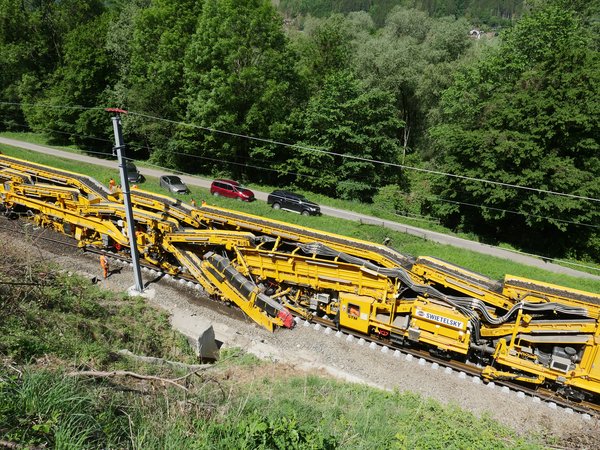Two-step ballast excavation
The main excavating chain removes the material in the sleeper area. It works in the construction gap, in the spot where the old sleepers have already been removed and the new ones have not yet been laid. Subsequently, two shoulder excavating units remove the material outside of the sleepers. This two-step process translates into one great benefit – a narrow excavating chain that protrudes less.
As a result, the RUS 1000 S or RU 800 S can work without interruption in narrow sections, for example, near bridges or in station platform areas. Other machine systems need to perform another step first: displace the track so there is sufficient space between it and any fixed structures.
The RU 800 S demonstrated the cost-efficiency of this concept during many jobs
The RU 800 S has been in operation in Europe for over 14 years, demonstrating great success and reliability. The number of jobs attest to a growing interest in this technology: the RU 800 S operated on tracks in ten European countries (Germany, the Netherlands, Belgium, Luxembourg, Sweden, Czechia, Hungary, Slovakia, Switzerland, and Austria). It has renewed and cleaned approximately 2,000 km of track to date. In the past few years, it worked on 140 to 150 km of track on average. In most cases, these distances consisted of several small sections of track under repair. During these jobs, the machine achieved impressive peak outputs: in Sweden, for example, where 2,200 m of track were completed in ten hours. These types of worksites place high demands on material logistics.
The advantages of a narrow excavating width
- No preparatory work required on the track, e.g. displacing the rails near station platforms, before the machine arrives
- Uninterrupted operation, even in confined spaces such as station platform areas, concrete semi-through bridges, drainage systems, or in tunnels
- Adjustable ballast excavating width of 3,000 to 5,800 mm by combining the excavating chain with the shoulder scoops



